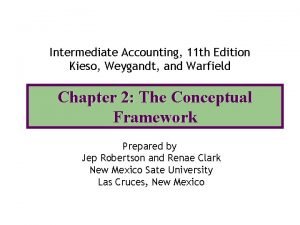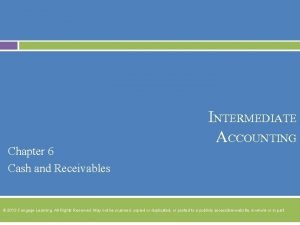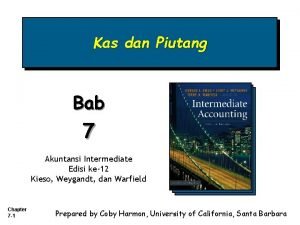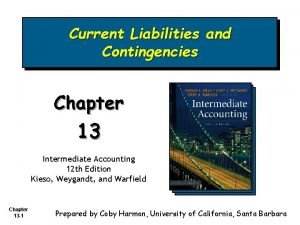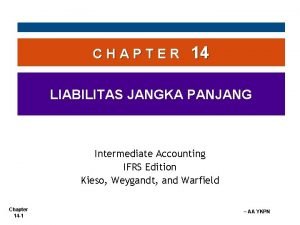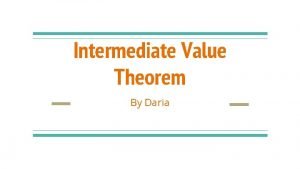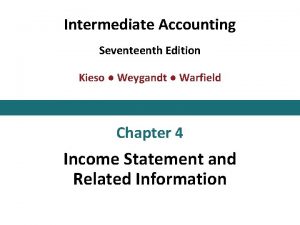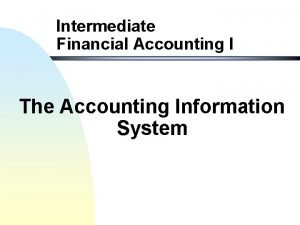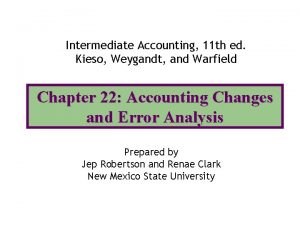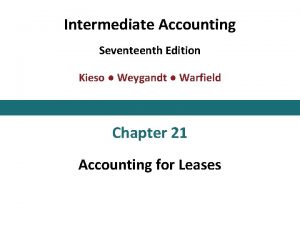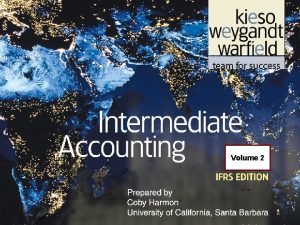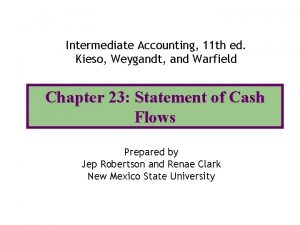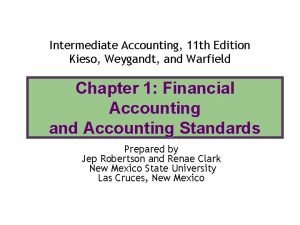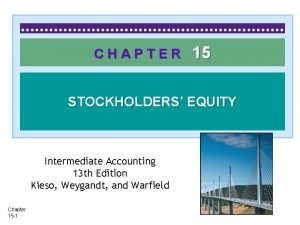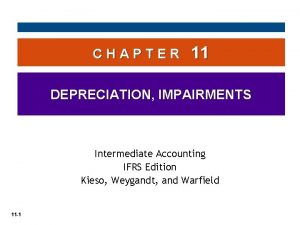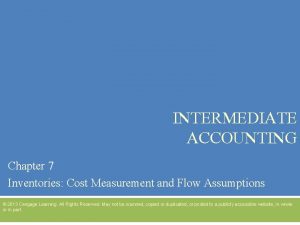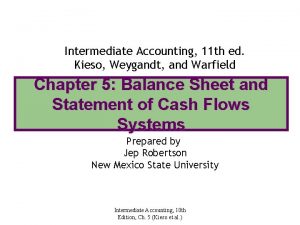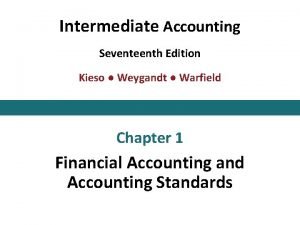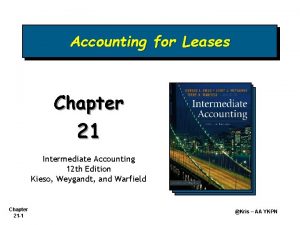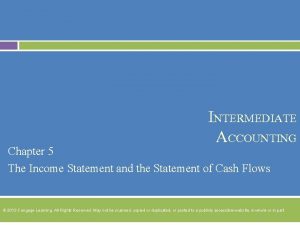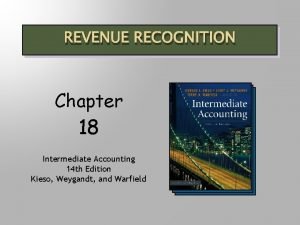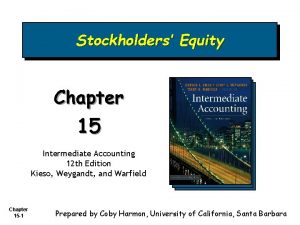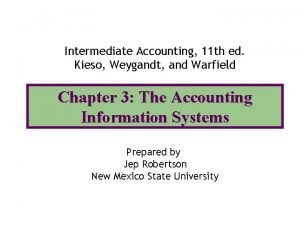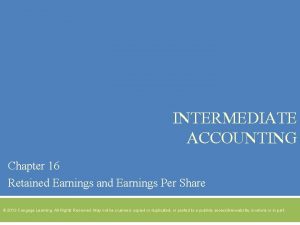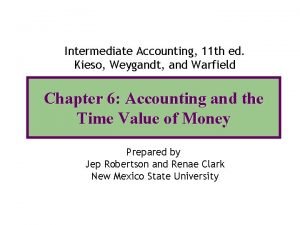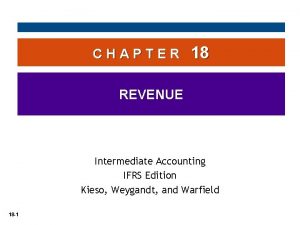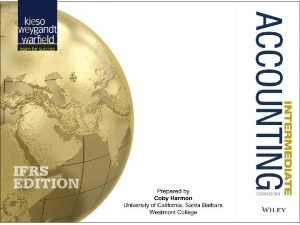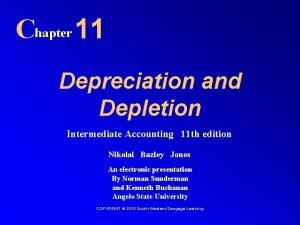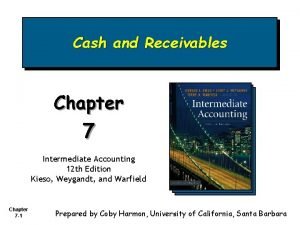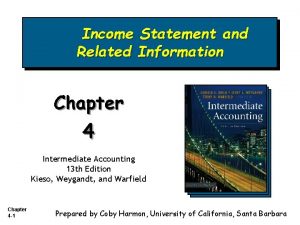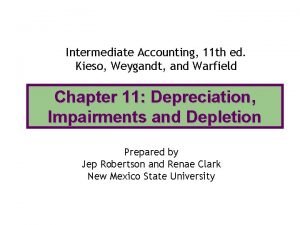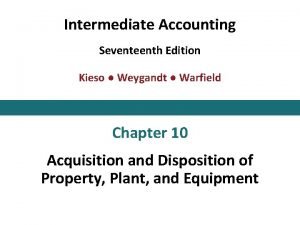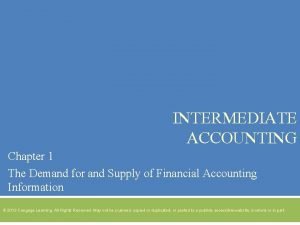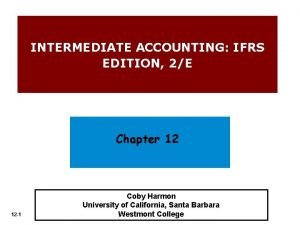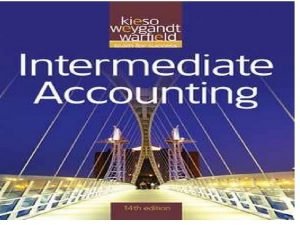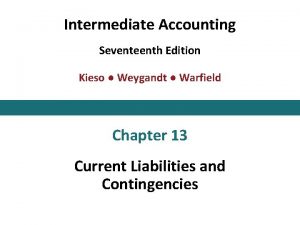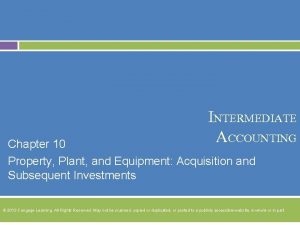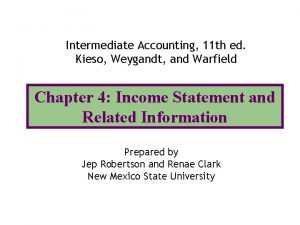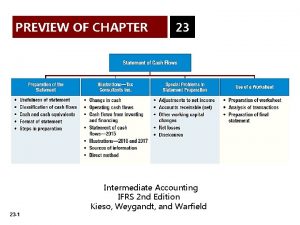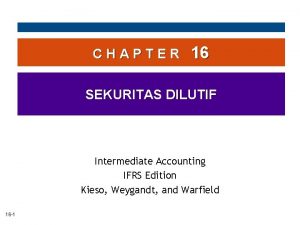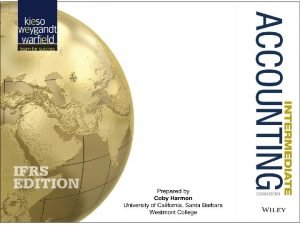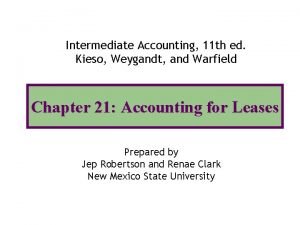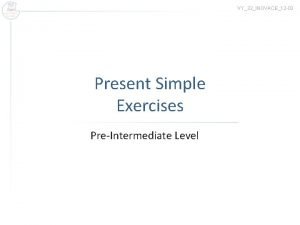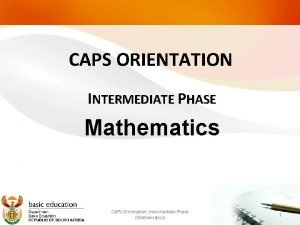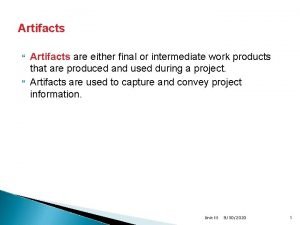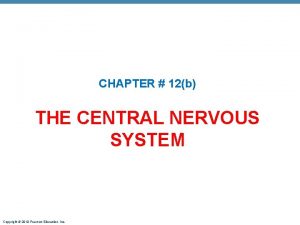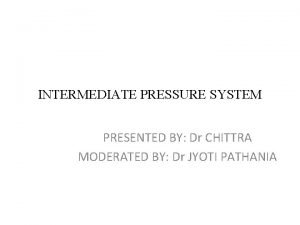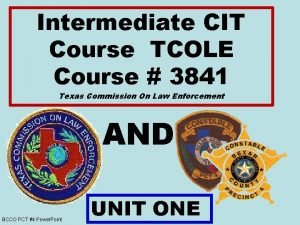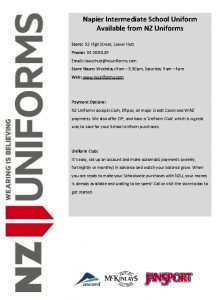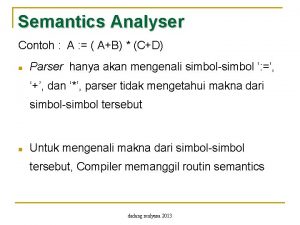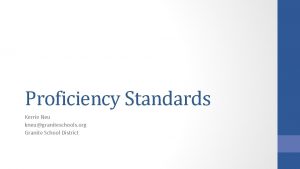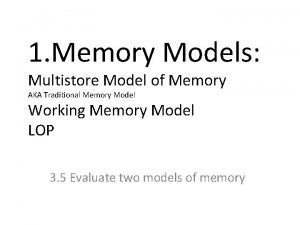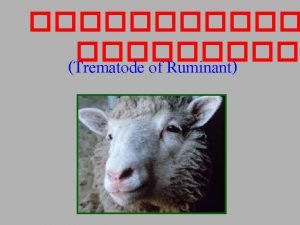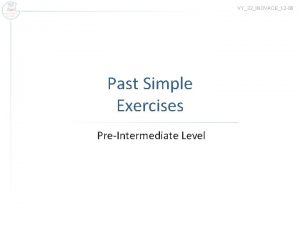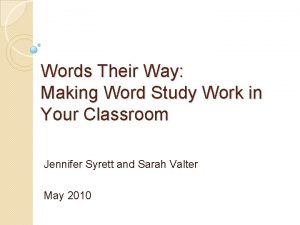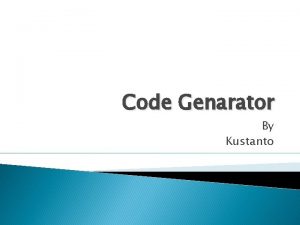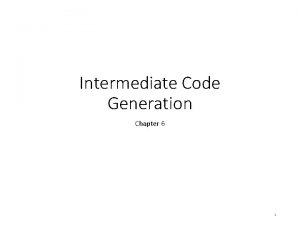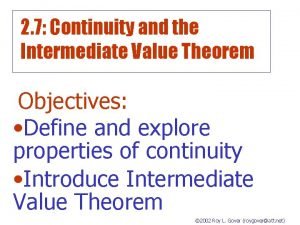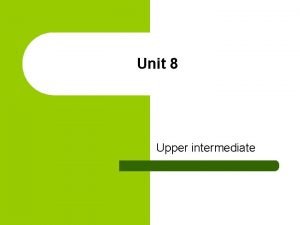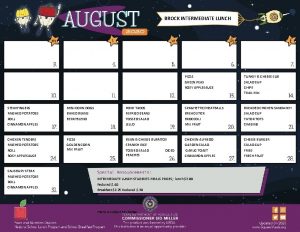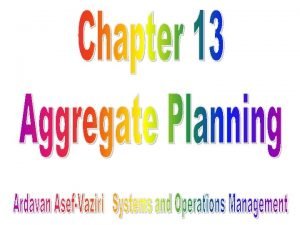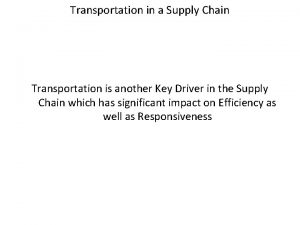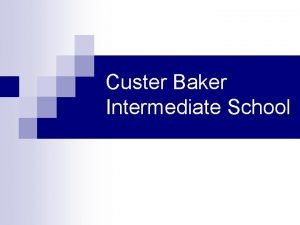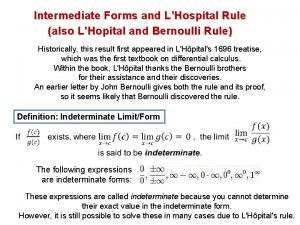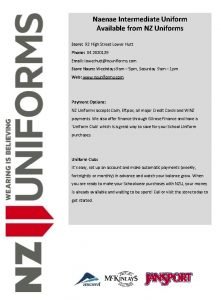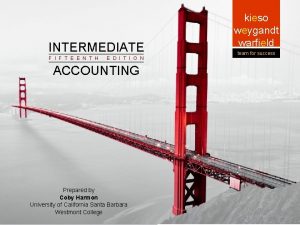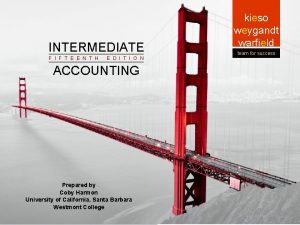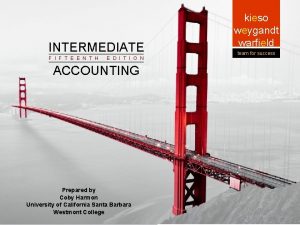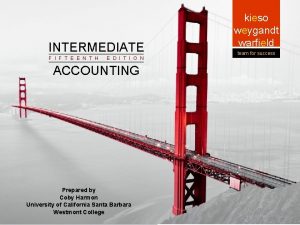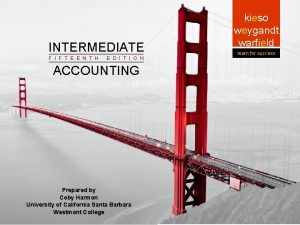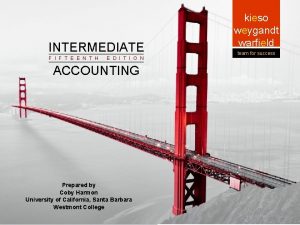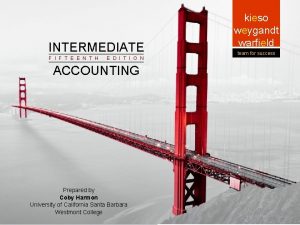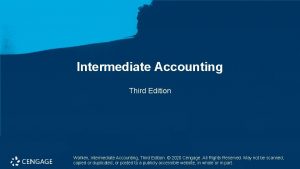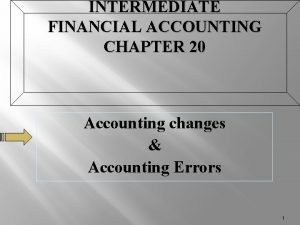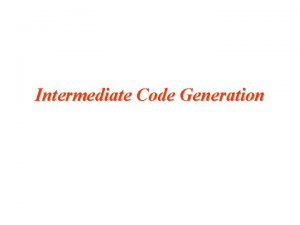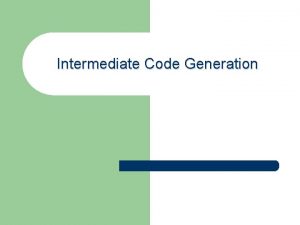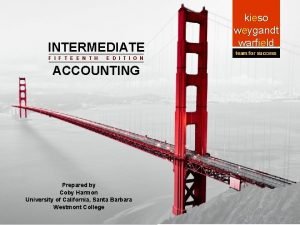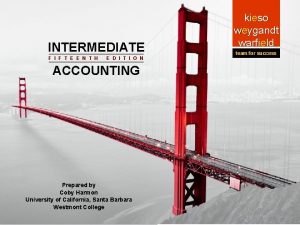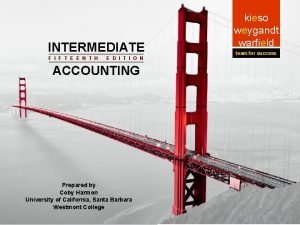INTERMEDIATE Intermediate ACCOUNTING Intermediate Accounting F I F
























































































































- Slides: 120

INTERMEDIATE Intermediate ACCOUNTING Intermediate Accounting F I F T E E N T H 3 -1 E D I T I O N Prepared by Coby Harmon University of California Santa Barbara University of California, Santa Barbara Westmont College kieso weygandt warfield team for success

PREVIEW OF CHAPTER 3 Intermediate Accounting 15 th Edition Kieso Weygandt Warfield 3 -2

3 The Accounting Information System LEARNING OBJECTIVES After studying this chapter, you should be able to: 3 -3 1. Understand basic accounting terminology. 2. Explain double-entry rules. 3. Identify steps in the accounting cycle. 4. Record transactions in journals, post to ledger accounts, and prepare a trial balance. 5. Explain the reasons for preparing adjusting entries and identify major types of adjusting entries. 6. Prepare financial statements from the adjusted trial balance. 7. Prepare closing entries. 8. Prepare financial statements for a merchandising company.

Accounting Information System Accounting information system 3 -4 u Collects and processes transaction data. u Disseminates the financial information to interested parties. LO 1 Understand basic accounting terminology.

Accounting Information System Helps management answer such questions as: 3 -5 u How much and what kind of debt is outstanding? u Were sales higher this period than last? u What assets do we have? u What were our cash inflows and outflows? u Did we make a profit last period? u Are any of our product lines or divisions operating at a loss? u Can we safely increase our dividends to stockholders? u Is our rate of return on net assets increasing? LO 1 Understand basic accounting terminology.

Accounting Information System Basic Terminology 3 -6 u Event u Journal u Transaction u Posting u Account u Trial Balance u Real Account u Adjusting Entries u Nominal Account u Financial Statements u Ledger u Closing Entries LO 1 Understand basic accounting terminology.

3 The Accounting Information System LEARNING OBJECTIVES After studying this chapter, you should be able to: 3 -7 1. Understand basic accounting terminology. 2. Explain double-entry rules. 3. Identify steps in the accounting cycle. 4. Record transactions in journals, post to ledger accounts, and prepare a trial balance. 5. Explain the reasons for preparing adjusting entries and identify major types of adjusting entries. 6. Prepare financial statements from the adjusted trial balance. 7. Prepare closing entries. 8. Prepare financial statements for a merchandising company.

Accounting Information System Debits and Credits u An account shows the effect of transactions on a given asset, liability, equity, revenue, or expense account. 3 -8 u Double-entry accounting system (two-sided effect). u Recording done by debiting at least one account and crediting another. u DEBITS must equal CREDITS. LO 2 Explain double-entry rules.

Debits and Credits Account u An arrangement that shows the effect of transactions on an account. u Debit = “Left” u Credit = “Right” An Account can be illustrated in a T-Account form. 3 -9 LO 2 Explain double-entry rules.

Debits and Credits If the sum of Debit entries are greater than the sum of Credit entries, the account will have a debit balance. Transaction #1 $10, 000 Transaction #3 8, 000 Balance 3 -10 $3, 000 Transaction #2 $15, 000 LO 2 Explain double-entry rules.

Debits and Credits If the sum of Credit entries are greater than the sum of Debit entries, the account will have a credit balance. Transaction #1 Balance 3 -11 $10, 000 $3, 000 Transaction #2 8, 000 Transaction #3 $1, 000 LO 2 Explain double-entry rules.

Debits and Credits Summary Normal Balance Debit 3 -12 Normal Balance Credit LO 2 Explain double-entry rules.

Debits and Credits Summary Balance Sheet Income Statement Asset = Liability + Equity Revenue - Expense Debit Credit 3 -13 LO 2 Explain double-entry rules.

The Accounting Equation Relationship among the assets, liabilities and stockholders’ equity accounts of a business: Illustration 3 -3 The equation must be in balance after every transaction. For every Debit there must be a Credit. 3 -14 LO 2 Explain double-entry rules.

Double-Entry System Illustration 1. Owners invest $40, 000 in exchange for common stock. Assets + 40, 000 3 -15 = Liabilities + Stockholders’ Equity + 40, 000 LO 2 Explain double-entry rules.

Double-Entry System Illustration 2. Disburse $600 cash for secretarial wages. Assets - 600 = Liabilities + Stockholders’ Equity - 600 (expense) 3 -16 LO 2 Explain double-entry rules.

Double-Entry System Illustration 3. Purchase office equipment priced at $5, 200, giving a 10 percent promissory note in exchange. Assets + 5, 200 3 -17 = Liabilities + Stockholders’ Equity + 5, 200 LO 2 Explain double-entry rules.

Double-Entry System Illustration 4. Received $4, 000 cash for services performed. Assets + 4, 000 = Liabilities + Stockholders’ Equity + 4, 000 (revenue) 3 -18 LO 2 Explain double-entry rules.

Double-Entry System Illustration 5. Pay off a short-term liability of $7, 000. Assets - 7, 000 3 -19 = Liabilities + Stockholders’ Equity - 7, 000 LO 2 Explain double-entry rules.

Double-Entry System Illustration 6. Declared a cash dividend of $5, 000. Assets = Liabilities + 5, 000 3 -20 + Stockholders’ Equity - 5, 000 LO 2 Explain double-entry rules.

Double-Entry System Illustration 7. Convert a long-term liability of $80, 000 into common stock. Assets = Liabilities - 80, 000 3 -21 + Stockholders’ Equity + 80, 000 LO 2 Explain double-entry rules.

Double-Entry System Illustration 8. Pay cash of $16, 000 for a delivery van. Assets = Liabilities + Stockholders’ Equity - 16, 000 + 16, 000 Note that the accounting equation equality is maintained after recording each transaction. 3 -22 LO 2 Explain double-entry rules.

Financial Statements and Ownership Structure Ownership structure dictates the types of accounts that are part of or affect the equity section. Proprietorship or Partnership 3 -23 Corporation l Owner’s Capital l Common Stock l Owner’s Drawing l Paid-in Capital in Excess of Par l Dividends l Retained Earnings LO 2 Explain double-entry rules.

Financial Statements and Ownership Structure Illustration 3 -4 Balance Sheet Stockholders’ Equity Common Stock Retained Earnings (investments by stockholders) (net income retained in business) Net income or Net loss Dividends (revenues less expenses) Income Statement of Retained Earnings 3 -24 LO 2 Explain double-entry rules.

3 The Accounting Information System LEARNING OBJECTIVES After studying this chapter, you should be able to: 3 -25 1. Understand basic accounting terminology. 2. Explain double-entry rules. 3. Identify steps in the accounting cycle. 4. Record transactions in journals, post to ledger accounts, and prepare a trial balance. 5. Explain the reasons for preparing adjusting entries and identify major types of adjusting entries. 6. Prepare financial statements from the adjusted trial balance. 7. Prepare closing entries. 8. Prepare financial statements for a merchandising company.

The Accounting Cycle Illustration 3 -6 Transactions Reversing entries Journalization Post-closing trail balance Posting Closing Trial balance Statement preparation Work Sheet Adjustments Adjusted trial balance 3 -26 LO 3 Identify steps in the accounting cycle.

Identify and Recording Transactions What to Record? The FASB used the phrase “transactions and other events and circumstances that affect a business enterprise. ” Types of Events: 3 -27 u External – between an entity and its environment. u Internal – event occurring entirely within an entity. LO 3 Identify steps in the accounting cycle.

3 The Accounting Information System LEARNING OBJECTIVES After studying this chapter, you should be able to: 3 -28 1. Understand basic accounting terminology. 2. Explain double-entry rules. 3. Identify steps in the accounting cycle. 4. Record transactions in journals, post to ledger accounts, and prepare a trial balance. 5. Explain the reasons for preparing adjusting entries and identify major types of adjusting entries. 6. Prepare financial statements from the adjusted trial balance. 7. Prepare closing entries. 8. Prepare financial statements for a merchandising company.

Journalizing General Journal – a chronological record of transactions. Journal Entries are recorded in the journal. September 1: Stockholders invested $15, 000 cash in the corporation in exchange for shares of stock. Purchased computer equipment for $7, 000 cash. Illustration 3 -7 3 -29 LO 4

Posting – Transferring amounts from journal to ledger. Illustration 3 -8 3 -30 LO 4

Posting An Expanded Example The purpose of transaction analysis is (1) to identify the type of account involved, and (2) to determine whether a debit or a credit is required. Keep in mind that every journal entry affects one or more of the following items: assets, liabilities, stockholders’ equity, revenues, or expenses. 3 -31 LO 4 Record transactions in journals, post to ledger accounts, and prepare a trial balance.

Posting 1. October 1: Stockholders invest $100, 000 cash in an advertising venture to be known as Pioneer Advertising Agency Inc. Oct. 1 Cash 100, 000 Common Stock Cash Debit 100, 000 3 -32 100, 000 Common Stock Credit Debit Credit 100, 000 LO 4 Record transactions in journals, post to ledger accounts, and prepare a trial balance.

Posting 2. October 1: Pioneer Advertising purchases office equipment costing $50, 000 by signing a 3 -month, 12%, $50, 000 note payable. Oct. 1 50, 000 Equipment 50, 000 Notes Payable Equipment Debit 50, 000 3 -33 Notes Payable Credit Debit Credit 50, 000 LO 4 Record transactions in journals, post to ledger accounts, and prepare a trial balance.

Posting 3. October 2: Pioneer Advertising receives a $12, 000 cash advance from KC, a client, for advertising services that are expected to be completed by December 31. Oct. 2 Cash 12, 000 Unearned Service Revenue Cash Debit 100, 000 12, 000 3 -34 12, 000 Unearned Service Revenue Credit Debit Credit 12, 000 LO 4 Record transactions in journals, post to ledger accounts, and prepare a trial balance.

Posting 4. October 3: Pioneer Advertising pays $9, 000 office rent, in cash, for October. Oct. 3 Rent Expense 9, 000 Cash Debit 100, 000 12, 000 3 -35 Rent Expense Credit 9, 000 Debit Credit 9, 000 LO 4 Record transactions in journals, post to ledger accounts, and prepare a trial balance.

Posting 5. October 4: Pioneer Advertising pays $6, 000 for a one-year insurance policy that will expire next year on September 30. Oct. 4 Prepaid Insurance 6, 000 Cash Debit 100, 000 12, 000 3 -36 Prepaid Insurance Credit 9, 000 6, 000 Debit Credit 6, 000 LO 4 Record transactions in journals, post to ledger accounts, and prepare a trial balance.

Posting 6. October 5: Pioneer Advertising purchases, for $25, 000 on account, an estimated 3 -month supply of advertising materials from Aero Supply. Oct. 5 Supplies 25, 000 Accounts Payable Supplies Debit 25, 000 3 -37 25, 000 Accounts Payable Credit Debit Credit 25, 000 LO 4 Record transactions in journals, post to ledger accounts, and prepare a trial balance.

Posting 7. October 9: Pioneer Advertising signs a contract with a local newspaper for advertising inserts (flyers) to be distributed starting the last Sunday in November. Pioneer will start work on the content of the flyers in November. Payment of $7, 000 is due following delivery of the Sunday papers containing the flyers. A business transaction has not occurred. There is only an agreement between Pioneer Advertising and the newspaper for the services to be performed in November. Therefore, no journal entry is necessary in October. 3 -38 LO 4 Record transactions in journals, post to ledger accounts, and prepare a trial balance.

Posting 8. October 20: Pioneer Advertising’s board of directors declares and pays a $5, 000 cash dividend to stockholders. Oct. 20 Dividends 5, 000 Cash Debit 100, 000 12, 000 3 -39 Dividends Credit 9, 000 6, 000 5, 000 Debit Credit 5, 000 LO 4 Record transactions in journals, post to ledger accounts, and prepare a trial balance.

Posting 9. October 26: Employees are paid every four weeks. The total payroll is $2, 000 per day. The pay period ended on Friday, October 26, with salaries and wages of $40, 000 being paid. Oct. 26 Salaries and Wages Expense Cash 40, 000 Cash Salaries and Wages Expense Debit 100, 000 12, 000 3 -40 40, 000 Credit 9, 000 6, 000 5, 000 40, 000 Debit Credit 40, 000 LO 4

Posting 10. October 31: Pioneer Advertising receives $28, 000 in cash and bills Copa Company $72, 000 for advertising services of $100, 000 performed in October. Oct. 31 Cash Accounts Receivable Service Revenue Cash Debit 100, 000 12, 000 28, 000 80, 000 3 -41 28, 000 72, 000 100, 000 Accounts Receivable Credit 9, 000 6, 000 5, 000 40, 000 Debit 72, 000 Credit Service Revenue Debit Credit 100, 000

Trial Balance Illustration 3 -19 Trial Balance – A list of each account and its balance; used to prove equality of debit and credit balances. 3 -42 LO 4

3 The Accounting Information System LEARNING OBJECTIVES After studying this chapter, you should be able to: 3 -43 1. Understand basic accounting terminology. 2. Explain double-entry rules. 3. Identify steps in the accounting cycle. 4. Record transactions in journals, post to ledger accounts, and prepare a trial balance. 5. Explain the reasons for preparing adjusting entries and identify major types of adjusting entries. 6. Prepare financial statements from the adjusted trial balance. 7. Prepare closing entries. 8. Prepare financial statements for a merchandising company.

Adjusting Entries Makes it possible to: u Report on the balance sheet the appropriate assets, liabilities, and owner’s equity at the statement date. u Report on the income statement the proper revenues and expenses for the period. ► Revenues are recorded in the period in which services are performed. ► Expenses are recognized in the period in which they are incurred. 3 -44 LO 5 Explain the reasons for preparing adjusting entries and identify major types of adjusting entries.

Types of Adjusting Entries Illustration 3 -20 3 -45 Deferrals Accruals 1. Prepaid Expenses paid in cash before they are used or consumed. 3. Accrued Revenues for services performed but not yet received in cash or recorded. 2. Unearned Revenues. Cash received before services are performed. 4. Accrued Expenses incurred but not yet paid in cash or recorded. LO 5 Explain the reasons for preparing adjusting entries and identify major types of adjusting entries.

Adjusting Entries for Deferrals are either u prepaid expenses or u unearned revenues. Illustration 3 -21 3 -46 LO 5

Adjusting Entries for Prepaid Expenses. Assets paid for and recorded before a company uses them. Cash Payment BEFORE Expense Recorded Prepayments often occur in regard to: 3 -47 u insurance u rent u supplies u buildings and equipment u advertising LO 5 Explain the reasons for preparing adjusting entries and identify major types of adjusting entries.

Adjusting Entries for Prepaid Expenses Supplies. Pioneer Advertising purchased advertising supplies costing $25, 000 on October 5. Prepare the journal entry to record the purchase of the supplies. Oct. 5 Supplies 25, 000 Cash 25, 000 Supplies Debit 25, 000 3 -48 Credit Cash Debit Credit 25, 000 LO 5

Adjusting Entries for Prepaid Expenses Supplies. An inventory count at the close of business on October 31 reveals that $10, 000 of the advertising supplies are still on hand. Oct. 31 Supplies Expense 15, 000 Supplies Debit 25, 000 15, 000 Supplies Expense Credit 15, 000 Debit Credit 15, 000 10, 000 3 -49 LO 5

Adjusting Entries for Prepaid Expenses PIONEER ADVERTISING AGENCY INC. Balance Sheet October 31, 2014 Illustration 3 -35 Statement Presentation: Supplies identifies that portion of the asset’s cost that will provide future economic benefit. 3 -50 Illustration 3 -35

Adjusting Entries for Prepaid Expenses Illustration 3 -35 Statement Presentation: PIONEER ADVERTISING AGENCY INC. Income Statement For the Month Ended October 31, 2014 Supplies expense identifies that portion of the asset’s cost that expired in October. 3 -51 LO 5 Explain the reasons for preparing adjusting entries and identify major types of adjusting entries.

Adjusting Entries for Prepaid Expenses Insurance. On Oct. 4 th, Pioneer Advertising paid $6, 000 for a one-year fire insurance policy, coverage beginning October 1. Prepare the entry to record the purchase of the insurance. Oct. 4 Prepaid Insurance 6, 000 Cash 6, 000 Prepaid Insurance Debit 6, 000 3 -52 Credit Cash Debit Credit 6, 000 LO 5

Adjusting Entries for Prepaid Expenses Insurance. An analysis of the policy reveals that $500 ($6, 000 ÷ 12) of insurance expires each month. Prepare the entry to record the insurance cost expired in October. Oct. 31 Insurance Expense 500 Prepaid Insurance Debit 6, 000 Credit 500 Insurance Expense Debit Credit 500 5, 500 3 -53 LO 5

Adjusting Entries for Prepaid Expenses PIONEER ADVERTISING AGENCY INC. Balance Sheet October 31, 2014 Illustration 3 -35 Statement Presentation: Prepaid insurance identifies that portion of the asset’s cost that will provide future economic benefit. 3 -54 Illustration 3 -35

Adjusting Entries for Prepaid Expenses Illustration 3 -35 Statement Presentation: PIONEER ADVERTISING AGENCY INC. Income Statement For the Month Ended October 31, 2014 Insurance expense identifies that portion of the asset’s cost that expired in October. 3 -55 LO 5 Explain the reasons for preparing adjusting entries and identify major types of adjusting entries.

Adjusting Entries for Prepaid Expenses Depreciation. Pioneer Advertising estimates depreciation on its office equipment to be $400 per month. Prepare the entry to record depreciation for the month of October. Oct. 31 Depreciation Expense 400 Accumulated Depreciation Expense Debit 400 3 -56 Credit 400 Accumulated Depreciation Debit Credit 400 LO 5

Adjusting Entries for Prepaid Expenses PIONEER ADVERTISING AGENCY INC. Balance Sheet October 31, 2014 Illustration 3 -35 Statement Presentation: Accumulated Depreciation is a contra asset account. 3 -57 Illustration 3 -35

Adjusting Entries for Prepaid Expenses Illustration 3 -35 Statement Presentation: PIONEER ADVERTISING AGENCY INC. Income Statement For the Month Ended October 31, 2014 Depreciation expense identifies that portion of the asset’s cost that expired in October. 3 -58 LO 5 Explain the reasons for preparing adjusting entries and identify major types of adjusting entries.

Adjusting Entries for Unearned Revenues Receipt of cash before the services are performed is recorded as a liability called unearned revenues. Cash Receipt BEFORE Revenue Recorded Unearned revenues often occur in regard to: 3 -59 u rent u magazine subscriptions u airline tickets u customer deposits u tuition LO 5 Explain the reasons for preparing adjusting entries and identify major types of adjusting entries.

Adjusting Entries for Unearned Revenues Unearned Revenue. Pioneer Advertising received $12, 000 on October 2 nd from KC for advertising services expected to be completed by December 31. Prepare the journal entry to record the receipt on October 2 nd. Oct. 2 Cash 12, 000 Unearned Service Revenue Cash Debit 12, 000 3 -60 12, 000 Unearned Service Revenue Credit Debit Credit 12, 000 LO 5

Adjusting Entries for Unearned Revenues. Analysis reveals that Pioneer Advertising earned $4, 000 of the advertising services in October. Prepare the entry to record the revenue for services performed. Oct. 31 Unearned Service Revenue 4, 000 Service Revenue Debit Credit 100, 000 4, 000 104, 000 3 -61 4, 000 Unearned Service Revenue Debit 4, 000 Credit 12, 000 8, 000 LO 5

Adjusting Entries for Unearned Revenues Statement Presentation: Unearned service revenue identifies that portion of the liability for which services have not been performed. 3 -62 Illustration 3 -35 PIONEER ADVERTISING AGENCY INC. Balance Sheet October 31, 2014 Illustration 3 -35

Adjusting Entries for Unearned Revenues Statement Presentation: Illustration 3 -35 PIONEER ADVERTISING AGENCY INC. Income Statement For the Month Ended October 31, 2014 Service Revenue includes the portion of unearned service revenue for which services were performed in October. 3 -63 LO 5 Explain the reasons for preparing adjusting entries and identify major types of adjusting entries.

Adjusting Entries for Accruals are either u accrued revenues or u accrued expenses. Illustration 3 -27 3 -64 LO 5

Adjusting Entries for Accrued Revenues recorded for services performed but cash has yet to be received at the statement date are accrued revenues. Adjusting entry results in: Revenue Recorded BEFORE Cash Receipt Accrued revenues often occur in regard to: 3 -65 u rent u interest u services performed LO 5 Explain the reasons for preparing adjusting entries and identify major types of adjusting entries.

Adjusting Entries for Accrued Revenues. In October Pioneer Advertising performed services worth $2, 000 that were not billed clients before Oct. 31. Prepare the entry to revenues for services performed. Oct. 31 Accounts Receivable 2, 000 Service Revenue Accounts Receivable Debit 3 -66 Credit 2, 000 Service Revenue Debit Credit 72, 000 100, 000 4, 000 2, 000 74, 000 106, 000 LO 5

Adjusting Entries for Accrued Revenues PIONEER ADVERTISING AGENCY INC. Balance Sheet October 31, 2014 Illustration 3 -35 PIONEER ADVERTISING AGENCY INC. Income Statement For the Month Ended October 31, 2014 3 -67 LO 5

Adjusting Entries for Accrued Expenses incurred but not yet paid in cash or recorded. Adjusting entry results in: Expense Recorded BEFORE Cash Payment Accrued expenses often occur in regard to: 3 -68 u rent u taxes u interest u salaries LO 5 Explain the reasons for preparing adjusting entries and identify major types of adjusting entries.

Adjusting Entries for Accrued Expenses Accrued Interest. Pioneer Advertising signed a three-month note payable in the amount of $50, 000 on October 1. The note requires interest at an annual rate of 12 percent. Three factors determine the amount of the interest accumulation: 1 3 -69 2 3 Illustration 3 -29 LO 5 Explain the reasons for preparing adjusting entries and identify major types of adjusting entries.

Adjusting Entries for Accrued Expenses Accrued Interest. Pioneer signed a three-month, 12%, note payable in the amount of $50, 000 on October 1. Prepare the adjusting entry on Oct. 31 to record the accrual of interest. Oct. 31 Interest Expense 500 Interest Payable Interest Expense Debit 500 3 -70 Credit 500 Interest Payable Debit Credit 500 LO 5

Adjusting Entries for Accrued Expenses PIONEER ADVERTISING AGENCY INC. Balance Sheet October 31, 2014 Illustration 3 -35 PIONEER ADVERTISING AGENCY INC. Income Statement For the Month Ended October 31, 2014 3 -71 LO 5

Adjusting Entries for Accrued Expenses Accrued Salaries and Wages. At October 31, the salaries and wages for these days represent an accrued expense and a related liability to Pioneer. The employees receive total salaries of $10, 000 for a five-day work week, or $2, 000 per day. 3 -72 LO 5

Adjusting Entries for Accrued Expenses Accrued Salaries. Employees receive total salaries and wages of $10, 000 for a five-day work week, or $2, 000 per day. Prepare the adjusting entry on Oct. 31 to record accrual for salaries. Oct. 31 Salaries and Wages Expense Salaries and Wages Payable Salaries and Wages Expense Debit 40, 000 6, 000 Credit 6, 000 Salaries and Wages Payable Debit Credit 6, 000 46, 000 3 -73 LO 5

Adjusting Entries for Accrued Expenses Accrued Salaries. On November 23, Pioneer will again pay total salaries and wages of $40, 000. Prepare the entry to record the payment of salaries on November 23. Nov. 23 Salaries and Wages Payable 6, 000 Salaries and Wages Expense 34, 000 Cash 40, 000 Salaries and Wages Expense Debit 34, 000 3 -74 Credit Salaries and Wages Payable Debit 6, 000 Credit 6, 000 LO 5

Adjusting Entries for Accrued Expenses PIONEER ADVERTISING AGENCY INC. Balance Sheet October 31, 2014 Illustration 3 -35 PIONEER ADVERTISING AGENCY INC. Income Statement For the Month Ended October 31, 2014 3 -75 LO 5

WHAT’S AM I COVERED? YOUR PRINCIPLE Rather than purchasing insurance to cover casualty losses and other obligations, some companies “self-insure. ” That is, a company decides to pay for any possible claims, as they arise, out of its own resources. The company also purchases an insurance policy to cover losses that exceed certain amounts. For example, Almost Family, Inc. , a healthcare services company, has a self-insured employee healthbenefit program. However, Almost Family ran into accounting problems when it failed to record an accrual of the liability for benefits not covered by its back-up insurance policy. This led to restatement of Almost Family’s fiscal results for the accrual of the benefit expense. 3 -76 LO 5 Explain the reasons for preparing adjusting entries and identify major types of adjusting entries.

Adjusting Entries for Accrued Expenses Bad Debts. Pioneer Advertising reasonably estimates a bad debt expense for the month of $1, 600. Prepare the entry to record the bad debts for the month of October. Oct. 31 Bad Debt Expense 1, 600 Allowance for Doubtful Accounts 1, 600 Illustration 3 -32 3 -77 LO 5

Adjusting Entries for Accrued Expenses PIONEER ADVERTISING AGENCY INC. Balance Sheet October 31, 2014 Illustration 3 -35 PIONEER ADVERTISING AGENCY INC. Income Statement For the Month Ended October 31, 2014 3 -78 LO 5

Adjusted Trial Balance PIONEER ADVERTISING AGENCY INC. Shows the balance of all accounts, after adjusting entries, at the end of the accounting period. 3 -79 Illustration 3 -33 Adjusted Trial Balance October 31, 2014

3 The Accounting Information System LEARNING OBJECTIVES After studying this chapter, you should be able to: 3 -80 1. Understand basic accounting terminology. 2. Explain double-entry rules. 3. Identify steps in the accounting cycle. 4. Record transactions in journals, post to ledger accounts, and prepare a trial balance. 5. Explain the reasons for preparing adjusting entries and identify major types of adjusting entries. 6. Prepare financial statements from the adjusted trial balance. 7. Prepare closing entries. 8. Prepare financial statements for a merchandising company.

Preparing Financial Statements are prepared directly from the Adjusted Trial Balance. Income Statement 3 -81 Retained Earnings Statement Balance Sheet LO 6 Prepare financial statement from the adjusted trial balance.

Preparing Financial Statements Illustration 3 -34 3 -82 LO 6

Preparing Financial Statements Illustration 3 -35 3 -83 LO 6

WHAT’S 24/7 ACCOUNTING YOUR PRINCIPLE To achieve the vision of “ 24/7 accounting, ” a company must be able to update revenue, income, and balance sheet numbers every day within the quarter and publish them on the Internet. Such real-time reporting responds to the demand for more timely financial information made available to all investors—not just to analysts with access to company management. Two obstacles typically stand in the way of 24/7 accounting: having the necessary accounting systems to close the books on a daily basis, and reliability concerns associated with unaudited real-time data. Only a few companies have the necessary accounting capabilities. Cisco Systems, which pioneered the concept of the 24 -hour close, is one such company. 3 -84 LO 6 Prepare financial statement from the adjusted trial balance.

3 The Accounting Information System LEARNING OBJECTIVES After studying this chapter, you should be able to: 3 -85 1. Understand basic accounting terminology. 2. Explain double-entry rules. 3. Identify steps in the accounting cycle. 4. Record transactions in journals, post to ledger accounts, and prepare a trial balance. 5. Explain the reasons for preparing adjusting entries and identify major types of adjusting entries. 6. Prepare financial statements from the adjusted trial balance. 7. Prepare closing entries. 8. Prepare financial statements for a merchandising company.

Closing Entries Basic Process 3 -86 u To reduce the balance of the nominal (temporary) accounts to zero in order to prepare the accounts for the next period’s transactions. u To transfer all income statement account balances to the Retained Earnings account in owner’s equity. u Balance sheet (asset, liability, and equity) accounts are not closed. u Dividends are closed directly to the Retained Earnings account. LO 7 Prepare closing entries.

Closing Entries PIONEER ADVERTISING AGENCY INC. Adjusted Trial Balance October 31, 2014 Illustration 3 -33 Closing Journal Entries: Retained Earnings Dividends 5, 000 Service Revenue 106, 000 5, 000 Salaries & Wages Expense 46, 000 Supplies Expense Rent Expense 3 -87 15, 000 9, 000 Insurance Expense 500 Interest Expense 500 Depreciation Expense 400 Bad Debt Expense 1, 600 Retained Earnings 33, 000 LO 7 Prepare closing entries.

Post-Closing Trial Balance Illustration 3 -38 PIONEER ADVERTISING AGENCY INC. Post-Closing Trial Balance October 31, 2014 3 -88 LO 7

Accounting Cycle Summarized 1. Enter the transactions of the period in appropriate journals. 2. Post from the journals to the ledger (or ledgers). 3. Take an unadjusted trial balance (trial balance). 4. Prepare adjusting journal entries and post to the ledger(s). 5. Take a trial balance after adjusting (adjusted trial balance). 6. Prepare the financial statements from the second trial balance. 7. Prepare closing journal entries and post to the ledger(s). 8. Take a post-closing trial balance (optional). 9. Prepare reversing entries (optional) and post to the ledger(s). Reversing entries are covered in Appendix 3 B. 3 -89 LO 7 Prepare closing entries.

WHAT’S HEY, IT’S YOUR COMPLICATED PRINCIPLE The economic volatility of the past few years has left companies hungering for more timely and uniform financial information to help them react quickly to fast-changing conditions. As one expert noted, companies were extremely focused on trying to reduce costs and plan for the future better, but a lot of them discovered that they didn’t have the information they needed and they didn’t have the ability to get that information. The unsteady recession environment also made it risky for companies to interrupt their operations to get new systems up to speed. So what to do? Try to piecemeal upgrades each year or start a major overhaul of their internal systems? Best Buy, for example, has standardized as many of its systems as possible and has been steadily upgrading them over the past decade. Acquisitions can wreak havoc on reporting systems. Best Buy is choosy about when to standardize for companies it acquires, but it sometimes has to implement new systems after international deals. In other situations, a major overhaul is needed. For example, it is common for companies with a steady stream of acquisitions to have 50 to 70 general ledger systems. In those cases, a company cannot react well unless its systems are made compatible. So is it the big bang (major overhaul) or the piecemeal approach? It seems to depend. One thing is certain—good accounting systems are a necessity. Without one, the risk of failure is high. 3 -90 LO 7 Prepare closing entries.

3 The Accounting Information System LEARNING OBJECTIVES After studying this chapter, you should be able to: 3 -91 1. Understand basic accounting terminology. 2. Explain double-entry rules. 3. Identify steps in the accounting cycle. 4. Record transactions in journals, post to ledger accounts, and prepare a trial balance. 5. Explain the reasons for preparing adjusting entries and identify major types of adjusting entries. 6. Prepare financial statements from the adjusted trial balance. 7. Prepare closing entries. 8. Prepare financial statements for a merchandising company.

Financial Statements of a Merchandising Company UPTOWN CABINET CORP. Income Statement For the Year Ended December 31, 2014 3 -92 Illustration 3 -39 LO 8

Financial Statements of a Merchandising Company Illustration 3 -40 UPTOWN CABINET CORP. Statement of Retained Earnings For the Year Ended December 31, 2014 3 -93 LO 8 Prepare financial statements for a merchandising company.

Financial Statements of a Merchandising Company UPTOWN CABINET CORP. Balance Sheet As of December 31, 2014 Illustration 3 -41 3 -94 LO 8

WHAT’S STATEMENTS, YOUR PRINCIPLE PLEASE The use of a worksheet at the end of each month or quarter enables a company to prepare interim financial statements even though it closes the books only at the end of each year. For example, assume that Google closes its books on December 31, but it wants monthly financial statements. To do this, at the end of January, Google prepares an adjusted trial balance (using a worksheet as illustrated in Appendix 3 C) to supply the information needed for statements for January. At the end of February, it uses a worksheet again. Note that because Google did not close the accounts at the end of January, the income statement taken from the adjusted trial balance on February 28 will present the net income for two months. If Google wants an income statement for only the month of February, the company obtains it by subtracting the items in the January income statement from the corresponding items in the income statement for the two months of January and February. If Google executes such a process daily, it can realize “ 24/7 accounting” (see the “What Do the Numbers Mean? ” box on page 110). 3 -95 LO 8 Prepare financial statements for a merchandising company.

APPENDIX 3 A CASH-BASIS ACCOUNTING VERSUS ACCRUAL-BASIS ACCOUNTING Most companies use accrual-basis accounting. They u recognize revenue when the performance obligation is satisfied and u expenses in the period incurred, without regard to the time of receipt or payment of cash. Under the strict cash-basis, companies u record revenue only when they receive cash, and u record expenses only when they disperse cash. Cash basis financial statements are not in conformity with GAAP. 3 -96 LO 9 Differentiate the cash basis of accounting from the accrual basis of accounting.

APPENDIX 3 A CASH-BASIS ACCOUNTING VERSUS ACCRUAL-BASIS ACCOUNTING Illustration: Quality Contractor signs an agreement to construct a garage for $22, 000. In January, Quality begins construction, incurs costs of $18, 000 on credit, and by the end of January delivers a finished garage to the buyer. In February, Quality collects $22, 000 cash from the customer. In March, Quality pays the $18, 000 due the creditors. Illustration 3 A-1 3 -97 Advance slide in presentation mode to reveal answer. LO 9 Differentiate the cash basis of accounting from the accrual basis of accounting.

APPENDIX 3 A CASH-BASIS ACCOUNTING VERSUS ACCRUAL-BASIS ACCOUNTING Illustration: Quality Contractor signs an agreement to construct a garage for $22, 000. In January, Quality begins construction, incurs costs of $18, 000 on credit, and by the end of January delivers a finished garage to the buyer. In February, Quality collects $22, 000 cash from the customer. In March, Quality pays the $18, 000 due the creditors. Illustration 3 A-2 3 -98 Advance slide in presentation mode to reveal answer. LO 9 Differentiate the cash basis of accounting from the accrual basis of accounting.

APPENDIX 3 A CASH-BASIS ACCOUNTING VERSUS ACCRUAL-BASIS ACCOUNTING Conversion From Cash Basis To Accrual Basis Illustration: Dr. Diane Windsor, like many small business owners, keeps her accounting records on a cash basis. In the year 2014, Dr. Windsor received $300, 000 from her patients and paid $170, 000 for operating expenses, resulting in an excess of cash receipts over disbursements of $130, 000 ($300, 000 - $170, 000). At January 1 and December 31, 2014, she has accounts receivable, unearned service revenue, accrued liabilities, and prepaid expenses as shown in Illustration 3 A-5 3 -99 LO 9 Differentiate the cash basis of accounting from the accrual basis of accounting.

APPENDIX 3 A CASH-BASIS ACCOUNTING VERSUS ACCRUAL-BASIS ACCOUNTING Conversion From Cash Basis To Accrual Basis Illustration: Calculate service revenue on an accrual basis. Illustration 3 A-8 Illustration 3 A-5 3 -100 Advance slide in presentation mode to reveal answer. LO 9 Differentiate the cash basis of accounting from the accrual basis of accounting.

APPENDIX 3 A CASH-BASIS ACCOUNTING VERSUS ACCRUAL-BASIS ACCOUNTING Conversion From Cash Basis To Accrual Basis Illustration: Calculate operating expenses on an accrual basis. Illustration 3 A-11 Illustration 3 A-5 3 -101 Advance slide in presentation mode to reveal answer. LO 9 Differentiate the cash basis of accounting from the accrual basis of accounting.

APPENDIX 3 A CASH-BASIS ACCOUNTING VERSUS ACCRUAL-BASIS ACCOUNTING Conversion From Cash Basis To Accrual Basis Illustration 3 A-12 3 -102 LO 9

APPENDIX 3 A CASH-BASIS ACCOUNTING VERSUS ACCRUAL-BASIS ACCOUNTING Theoretical Weaknesses of the Cash Basis Today’s economy is considerably more lubricated by credit than by cash. The accrual basis, not the cash basis, recognizes all aspects of the credit phenomenon. Investors, creditors, and other decision makers seek timely information about a company’s future cash flows. 3 -103 LO 9 Differentiate the cash basis of accounting from the accrual basis of accounting.

APPENDIX 3 B USING REVERSING ENTRIES Illustration of Reversing Entries—Accruals Illustration 3 B-1 3 -104 LO 10 Identifying adjusting entries that may be reversed.

APPENDIX 3 B USING REVERSING ENTRIES Illustration of Reversing Entries—Deferrals Illustration 3 B-2 3 -105 LO 10 Identifying adjusting entries that may be reversed.

APPENDIX 3 B USING REVERSING ENTRIES Summary of Reversing Entries 1. All accruals should be reversed. 2. All deferrals for which a company debited or credited the original cash transaction to an expense or revenue account should be reversed. 3. Adjusting entries for depreciation and bad debts are not reversed. Recognize that reversing entries do not have to be used. Therefore, some accountants avoid them entirely. 3 -106 LO 10 Identifying adjusting entries that may be reversed.

APPENDIX 3 C USING A WORKSHEET: THE ACCOUNTING CYCLE REVISITED A company prepares a worksheet either on u columnar paper or u within a computer spreadsheet. A company uses the worksheet to adjust 3 -107 u account balances and u to prepare financial statements. LO 11 Prepare a 10 -column worksheet.

APPENDIX 3 C USING A WORKSHEET: THE ACCOUNTING CYCLE REVISITED Worksheet Columns 3 -108 u Trial Balance Columns u Adjustment Columns LO 11 Prepare a 10 -column worksheet.

APPENDIX 3 C USING A WORKSHEET: THE ACCOUNTING CYCLE REVISITED Illustration 3 C-1 Worksheet 3 -109

APPENDIX 3 C USING A WORKSHEET: THE ACCOUNTING CYCLE REVISITED Preparing Financial Statements from a Worksheet The Worksheet: 3 -110 u provides information needed for preparation of the financial statements. u Sorts data into appropriate columns, which facilitates the preparation of the statements. LO 11 Prepare a 10 -column worksheet.

APPENDIX 3 C USING A WORKSHEET: THE ACCOUNTING CYCLE REVISITED UPTOWN CABINET CORP. Income Statement For the Year Ended December 31, 2014 3 -111 Illustration 3 -39 LO 11

APPENDIX 3 C USING A WORKSHEET: THE ACCOUNTING CYCLE REVISITED Illustration 3 -40 UPTOWN CABINET CORP. Statement of Retained Earnings For the Year Ended December 31, 2014 3 -112 LO 11 Prepare a 10 -column worksheet.

APPENDIX 3 C UPTOWN CABINET CORP. Balance Sheet As of December 31, 2014 USING A WORKSHEET: THE ACCOUNTING CYCLE REVISITED Illustration 3 -41 3 -113 LO 11

RELEVANT FACTS - Similarities 3 -114 u International companies use the same set of procedures and records to keep track of transaction data. Thus, the material in Chapter 3 is the same under both GAAP and IFRS. u Transaction analysis is the same under IFRS and GAAP but, as you will see in later chapters, different standards sometimes impact how transactions are recorded. u Both the IASB and FASB go beyond the basic definitions provided in this textbook for the key elements of financial statements, that is, assets, liabilities, equity, revenues, and expenses. u A trial balance under IFRS follows the same format as shown in the textbook. LO 12 Compare the accounting information systems under GAAP and IFRS.

RELEVANT FACTS - Differences 3 -115 u Rules for accounting for specific events sometimes differ across countries. For example, European companies rely less on historical cost and more on fair value than U. S. companies. Despite the differences, the double-entry accounting system is the basis of accounting systems worldwide. u Internal controls are a system of checks and balances designed to prevent and detect fraud and errors. While most companies have these systems in place, many have never completely documented them nor had an independent auditor attest to their effectiveness. Both of these actions are required under SOX. Enhanced internal control standards apply only to large public companies listed on U. S. exchanges. LO 12 Compare the accounting information systems under GAAP and IFRS.

ON THE HORIZON The definitional structure of assets, liabilities, equity, revenues, and expenses may change over time as the IASB and FASB evaluate their overall conceptual framework for establishing accounting standards. In addition, high-quality international accounting requires both high-quality accounting standards and high-quality auditing. Similar to the convergence of GAAP and IFRS, there is a movement to improve international auditing standards. The International Auditing and Assurance Standards Board (IAASB) functions as an independent standard-setting body. It works to establish high-quality auditing and assurance and quality-control standards throughout the world. Whether the IAASB adopts internal control provisions similar to those in SOX remains to be seen. You can follow developments in the international audit arena at http: //www. ifac. org/iaasb/. 3 -116 LO 12 Compare the accounting information systems under GAAP and IFRS.

IFRS SELF-TEST QUESTION Information in a company’s first IFRS statements must: a. have a cost that does not exceed the benefits. b. be transparent. c. provide a suitable starting point. d. All the above. 3 -117 LO 12 Compare the accounting information systems under GAAP and IFRS.

IFRS SELF-TEST QUESTION The transition date is the date: a. when a company no longer reports under its national standards. b. when the company issues its most recent financial statement under IFRS. c. three years prior to the reporting date. d. None of the above. 3 -118 LO 12 Compare the accounting information systems under GAAP and IFRS.

IFRS SELF-TEST QUESTION When converting to IFRS, a company must: a. recast previously issued financial statements in accordance with IFRS. b. use GAAP in the reporting period but subsequently use IFRS. c. prepare at least three years of comparative statements. d. use GAAP in the transition year but IFRS in the reporting year. 3 -119 LO 12 Compare the accounting information systems under GAAP and IFRS.

Copyright © 2013 John Wiley & Sons, Inc. All rights reserved. Reproduction or translation of this work beyond that permitted in Section 117 of the 1976 United States Copyright Act without the express written permission of the copyright owner is unlawful. Request for further information should be addressed to the Permissions Department, John Wiley & Sons, Inc. The purchaser may make back-up copies for his/her own use only and not for distribution or resale. The Publisher assumes no responsibility for errors, omissions, or damages, caused by the use of these programs or from the use of the information contained herein. 3 -120
 Primary qualities of accounting information
Primary qualities of accounting information Cash and receivables intermediate accounting
Cash and receivables intermediate accounting Chapter 7 cash and receivables solutions
Chapter 7 cash and receivables solutions Chapter 13 intermediate accounting
Chapter 13 intermediate accounting Current liabilities and contingencies
Current liabilities and contingencies Chapter 14 intermediate accounting kieso bahasa indonesia
Chapter 14 intermediate accounting kieso bahasa indonesia Khan academy mean value theorem
Khan academy mean value theorem Income statement discontinued operations
Income statement discontinued operations Closing entries example
Closing entries example Intermediate accounting chapter 2
Intermediate accounting chapter 2 Intermediate accounting kieso
Intermediate accounting kieso Intermediate accounting
Intermediate accounting Types of leases
Types of leases Chapter 15 intermediate accounting
Chapter 15 intermediate accounting Cost of retained earnings
Cost of retained earnings Intermediate accounting chapter 17 investments test bank
Intermediate accounting chapter 17 investments test bank Intermediate accounting kieso
Intermediate accounting kieso What is intermediate accounting
What is intermediate accounting Intermediate accounting
Intermediate accounting Lessor versus lessee
Lessor versus lessee First level of conceptual framework
First level of conceptual framework Large stock dividend journal entry
Large stock dividend journal entry Chapter 11 intermediate accounting
Chapter 11 intermediate accounting Dollar value lifo
Dollar value lifo Advantages of financial accounting
Advantages of financial accounting Intermediate accounting
Intermediate accounting What is gaap in accounting
What is gaap in accounting Chapter 21 accounting for leases kieso terjemahan
Chapter 21 accounting for leases kieso terjemahan Multi step income statement
Multi step income statement Chapter 18 revenue recognition solutions
Chapter 18 revenue recognition solutions Intermediate accounting chapter 17 investments pdf
Intermediate accounting chapter 17 investments pdf Property dividend
Property dividend Intermediate accounting kieso
Intermediate accounting kieso A restriction/appropriation of retained earnings
A restriction/appropriation of retained earnings Intermediate accounting kieso
Intermediate accounting kieso Chapter 18 kieso
Chapter 18 kieso Lcnrv adalah
Lcnrv adalah Chapter 11 depreciation impairments and depletion
Chapter 11 depreciation impairments and depletion Zero interest bearing note
Zero interest bearing note Income statement and related information chapter 4
Income statement and related information chapter 4 Impairment in finance meaning
Impairment in finance meaning Commercial substance
Commercial substance Income tax expense
Income tax expense Intermediate accounting chapter 1
Intermediate accounting chapter 1 Financial accounting chapter 1
Financial accounting chapter 1 Kunci jawaban intermediate accounting chapter 12
Kunci jawaban intermediate accounting chapter 12 Revenue recognition intermediate accounting
Revenue recognition intermediate accounting Intermediate accounting chapter 15 equity bahasa indonesia
Intermediate accounting chapter 15 equity bahasa indonesia Intermediate accounting
Intermediate accounting Intermediate accounting chapter 10
Intermediate accounting chapter 10 Intermediate accounting kieso
Intermediate accounting kieso Chapter 23 statement of cash flows
Chapter 23 statement of cash flows Chapter 16 kieso
Chapter 16 kieso Chapter 3 intermediate accounting
Chapter 3 intermediate accounting Chapter 12 intangible assets
Chapter 12 intangible assets Intermediate accounting chapter 1
Intermediate accounting chapter 1 Intermediate accounting
Intermediate accounting Introduction to accounting software
Introduction to accounting software Accountin principles
Accountin principles Accounting responsibility
Accounting responsibility Upper intermediate unit 4
Upper intermediate unit 4 Intermediate filament
Intermediate filament Taenia solium
Taenia solium Cardinal directions picture
Cardinal directions picture Genetics is the study of heredity and variation
Genetics is the study of heredity and variation Lathrop intermediate school yearbook
Lathrop intermediate school yearbook Have got has got exercises
Have got has got exercises Caps maths intermediate phase
Caps maths intermediate phase Expenditure approach tagalog
Expenditure approach tagalog Intermediate artifacts can be assessed
Intermediate artifacts can be assessed Planatis
Planatis Intermediate-risk surgery list
Intermediate-risk surgery list Lentiform
Lentiform Compass rose
Compass rose Oxygen pressure
Oxygen pressure Intermediate filaments function
Intermediate filaments function Chelsea intermediate
Chelsea intermediate Tcole cit
Tcole cit What language
What language Nz uniforms lower hutt
Nz uniforms lower hutt Vw miller intermediate
Vw miller intermediate Contoh a
Contoh a Lathrop intermediate school
Lathrop intermediate school Novice intermediate advanced
Novice intermediate advanced Toxocara
Toxocara Intermediate processing psychology example
Intermediate processing psychology example The hard way out by terry vaughn
The hard way out by terry vaughn Eurytrema pancreaticum life cycle
Eurytrema pancreaticum life cycle Intermediate colors
Intermediate colors Platyhelminthes domain
Platyhelminthes domain Past simple de see
Past simple de see Words their way
Words their way Intermediate normoblast
Intermediate normoblast Diploma after 10th
Diploma after 10th Intermediate microeconomics lecture notes
Intermediate microeconomics lecture notes Input tahap intermediate code generator adalah
Input tahap intermediate code generator adalah Types and declarations in intermediate code generation
Types and declarations in intermediate code generation Mindraider
Mindraider Fluorochemical intermediate
Fluorochemical intermediate Itil intermediate rcv
Itil intermediate rcv Propiltiourasil paten
Propiltiourasil paten Lathrop intermediate school yearbook
Lathrop intermediate school yearbook Lacuna musculorum içindekiler
Lacuna musculorum içindekiler Speech emergence examples
Speech emergence examples Torn clothes
Torn clothes Adduction
Adduction The intermediate value theorem
The intermediate value theorem Jenks east intermediate
Jenks east intermediate Unit 8 upper intermediate
Unit 8 upper intermediate Intermediate mass of thalamus
Intermediate mass of thalamus Proportioning system anesthesia machine
Proportioning system anesthesia machine Brock intermediate lunch menu
Brock intermediate lunch menu Intermediate range capacity planning
Intermediate range capacity planning Direct shipping with milk runs
Direct shipping with milk runs Custer baker intermediate school
Custer baker intermediate school Intermediate document
Intermediate document Tom cox intermediate
Tom cox intermediate Lhospital rule
Lhospital rule Intermediate filament
Intermediate filament Intermediate unit 5
Intermediate unit 5 Naenae intermediate
Naenae intermediate
